Documentary Footage of the Inside of My Brain
Jane will be on Wednesday this week. Until then, what the title suggests, from KLF Night at something called The Cube. I have no idea, really. Which is true of the inside of my brain too.
…
Jane will be on Wednesday this week. Until then, what the title suggests, from KLF Night at something called The Cube. I have no idea, really. Which is true of the inside of my brain too.
…
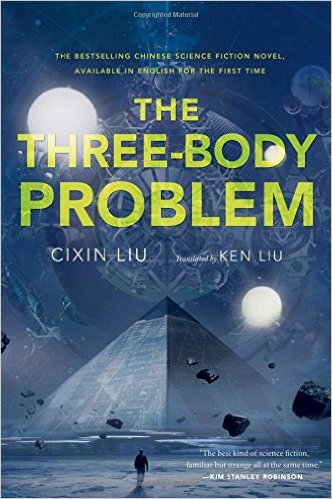 From my forthcoming colleciton Guided by the Beauty of Their Weapons: Notes on Science Fiction and Culture in the Year of Angry Dogs, available for preorder at Amazon and Amazon UK.
From my forthcoming colleciton Guided by the Beauty of Their Weapons: Notes on Science Fiction and Culture in the Year of Angry Dogs, available for preorder at Amazon and Amazon UK.
One of the most complex events surrounding the Hugos, at least in terms of untangling its meaning and significance, was the victory of Cixin Liu’s The Three-Body Problem, the first part of a trilogy, in the marquee category of Best Novel. On the night it looked like a triumph – a book that had originally been kept off the ballot by the Puppies that only got on when Marko Kloos withdrew himself in protest at the tactics that had gotten him on, and was the first time Best Novel had been won by a work not originally published in English, which was another welcome note of diversity in a night that needed them.
Beyond that, it was a genuinely good sci-fi book. This is in some ways distinct from calling it a genuinely good book; there’s definitely a bit of “grading on the curve” involved here whereby one excuses the fact that one of the two protagonists is woefully underdeveloped and seems to exist mostly to slowly work out one of the big sci-fi concepts (the eponymous Three-Body Problem) at the pace Liu wants that revelation to unfold and then to have a specific technical skill (and one entirely unrelated to the Three-Body Problem itself) needed in the climax. But it’s long on interesting ideas and does some fun stuff moving between two time periods, and the point of the Hugo Awards is in part to reward compelling sci-fi content over other literary merits.
And it’s worth stressing that the diversity aspect of it is a real one. The Three-Body Problem is the most successful work of science fiction in China in living memory. This matters, as does translating it into English where it can reach a smaller audience. It is of course absurd to saddle one book with the task of representing Chinese science fiction as a whole, and the topic is far enough from my areas of expertise that it’s not going to be the focus of this discussion, simply put, it’s extremely valuable just to get a window, however small, into this perspective. There’s nothing particularly strange or exotic about the book as such; there’s much more that’s familiar to a science fiction reader than not. But equally, it’s clearly a new perspective on a wealth of familiar tropes.
It wasn’t until people ran the numbers on the Hugo data the morning after that an unpleasant reality emerged, however: the margin of victory between The Three-Body Problem and the second-place novel, Katherine Addison’s The Goblin Emperor, was smaller than the number of voters who had voted in accordance with Vox Day’s recommendations, which included putting The Three-Body Problem in first place, ahead of any of his actual nominees. In other words, Vox Day could fairly be argued as being responsible for the victory.…
 I’m afraid this is going to be another one of those essays where I don’t have a whole lot to say or anything refreshingly new and interesting to add to the discourse. “Lessons” is bad, it’s bad for boring reasons and it’s bad in ways I’ve actually already discussed at great length in other posts. Normally this would be the kind of episode I’d throw into a multi-episode post, and while both this week’s Star Trek: The Next Generation and Star Trek: Deep Space Nine are both equally terrible, they have the obnoxious gall of not being terrible in complimentary ways, which precludes me from doing that.
I’m afraid this is going to be another one of those essays where I don’t have a whole lot to say or anything refreshingly new and interesting to add to the discourse. “Lessons” is bad, it’s bad for boring reasons and it’s bad in ways I’ve actually already discussed at great length in other posts. Normally this would be the kind of episode I’d throw into a multi-episode post, and while both this week’s Star Trek: The Next Generation and Star Trek: Deep Space Nine are both equally terrible, they have the obnoxious gall of not being terrible in complimentary ways, which precludes me from doing that.
I would say that the one unique thing I could say about “Lessons” is my statement of dislike itself…I was under the impression that while not considered a great classic or anything, this episode was reasonably warmly received by mainline fandom-A necessary next step in progressing Captain Picard’s story arc after “The Inner Light”. But even mainline fandom seems to be agreeing with me in this case, at least judging by the reaction this episode gets both on Memory Alpha and in Star Trek: The Next Generation 365: Its wiki page as of this writing looks neglected and incomplete and doesn’t even feature the usual quotes and statements from the production team in the notes that most Star Trek stories get, while Paula Block and Terry J. Erdmann couldn’t even be bothered to do anything more than halfheartedly re-state the story’s diegetic plot and themes in their own words.
I mean, let’s address the obvious points you know I’m going to bring up right off that bat. Doing a sequel to “The Inner Light” is stupid. Trying to set up a me-or-them contrast between voyaging, especially aboard the USS Enterprise NCC-1701-D, with a long-term relationship is a false dichotomy. Doing a naval (and navel-gazing) “involved with your subordinates” drama is hackneyed and trite. Captain Picard’s entire attitude feels off, the romance plot is 90s sitcom quality and Commander Riker acting like a jealous schoolboy envious of the teacher’s pet is an asinine and spectacularly out-of-character way to force banal conflict. That much should be obvious. But from my perspective, the problem here is that I’ve essentially already written the essay I wanted to write for this episode, except I did it for “The Outer Light”.
The whole reason I covered “The Outer Light” in the first place was to contrast it with “Lessons”. My idea was to set up my imagined plot for “The Outer Light” (which is not at all what the actual “Outer Light” was) as the proper way to do a sequel to “The Inner Light” while calling out “Lessons” for being rote, derivative and too hung up on an adolescent conception of materialism to add anything to the story worth hearing. My imaginary version of “The Outer Light” (which is not at all what the actual “Outer Light” was) had Captain Picard attending a summit of historians and scientific experts on Kataanian life and culture, all of whom had been contacted by the probe and experienced a slightly different version of the ancestor simulation programme.…
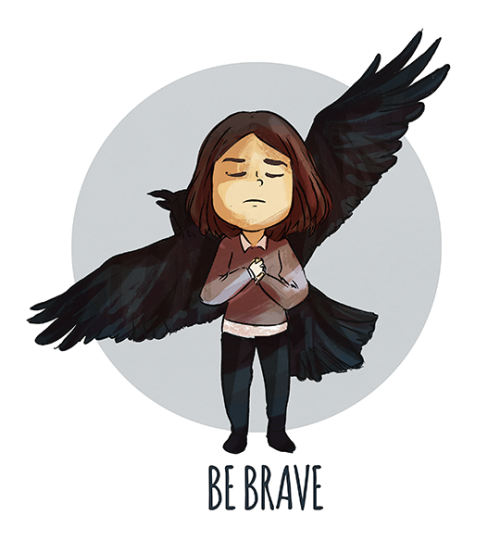 |
| Art by cardinalcapaldi |
Dollard for showrunner.
What is perhaps most striking about Face the Raven is its studious lack of flashiness. Especially given the extent to which the denouement involves the story nearly being swallowed whole by the season arc. By the end the episode is nearly as awash in references and metaplots as the start of The Magician’s Apprentice, and yet at no point does it lose sight of its underlying goal of being a fairly straightforward Doctor Who story in the “here is a cool premise, let’s explore it” tradition.
That’s not to say that there aren’t some obvious moments where Dollard’s story gets sacrificed to the needs of the season arc. In particular, the fact that Me’s benefactors have to go unnamed (though they’re obviously the Time Lords, right?) and the entire “what the hell is going on here” is offloaded to, at the very least, Heaven Sent and one suspects at least partially Hell Bent means that this all feels a bit messy. It’s a mystery, and yet it never quite feels like it comes to a solution. Particularly awkward is the fact that the Doctor seems to more or less arbitrarily remember the whole “burn their dead” thing when it’s convenient to move the plot along.
But crucially, Dollard handles each of her two briefs here well enough that the slight awkwardness of the transition between them is largely beside the point. The first chunk of the story, prior to the Doctor turning the key, is raw cleverness. Of particular note is the deftness with which Dollard ditches one premise for another. The trap street is clever, and very Doctor Who. Similar ideas exist in other media – Danny the Street in Doom Patrol and the Wandering Shop in Discworld spring to mind off the top of my head, and I’m sure your head will provide as well. But it’s also necessarily a setup to another kind of story, and the handoff to “alien refugee camp” is well-timed and well-executed.
Moreover, though, “alien refugee camp” is a flat-out astonishing premise. And “murdery mystery in an alien refugee camp” is an even better one. Indeed, its compression into a third of a single episode has to go down as one of the most ridiculously swift disposals of a promising premise in the history of the season, and one really wonders what on Earth was ever going to happen in the parallel world where we spent two weeks on Sleep No More. But even in its ultra-compressed form it works well, with the elements fitting together in a satisfying fashion that builds ominously while also giving the audience sufficient opportunities to feel clever.
As for the second chunk, what is there to say? Not for the first, but nearly for the last time Capaldi and Coleman are given astonishingly good material, and they do astonishing things with it. Notice the structural cleverness of it: the cliffhanger is identical to The Magician’s Apprentice: Clara’s dead and the Doctor’s trapped.…
We haven’t done one of these in a while, now have we?
Hope you’re doing well. I’m slightly under the weather, with a generic November drear as western Connecticut gears up for another round of “let’s try not to fucking freeze to death,” but in good spirits. I’m literally putting the finishing touches on Guided by the Beauty of Their Weapons, my definitive statement on 2015, which has been a real problematic fave of a year. That’s out the day after Christmas. I’m excited for it. I was just rereading the rewritten version of the title essay, and man, I am genuinely proud of that thing. It’s now a 19,000 word epic, and I look forward to sharing it with you.
I’ve also unexpectedly started writing a book that wasn’t really on the schedule or in any plans, but just sort of happened to me. It’s currently 18,000 words long, and nowhere near done. It’s a work of theory, because clearly everyone was waiting for one of those from me. Its starting points are the neoreactionaries, particularly Mencius Moldbug and Nick Land, as well as the work of Elizier Yudkowsky. It does many other things. I have some neat ideas on how to sell it, so look for that in 2016.
Anyway, how have you been? And better yet, who are you? Say hello, dear readers. If the Captchas will let you. …
Previously in The Last War in Albion: Following the tempest in a teapot that was the DC ratings system controversy, Moore and DC parted ways with acrimony on both sides, and more to the point with a near complete failure to understand each other, with Moore taking what he viewed as a principled stand and DC making a business decision.
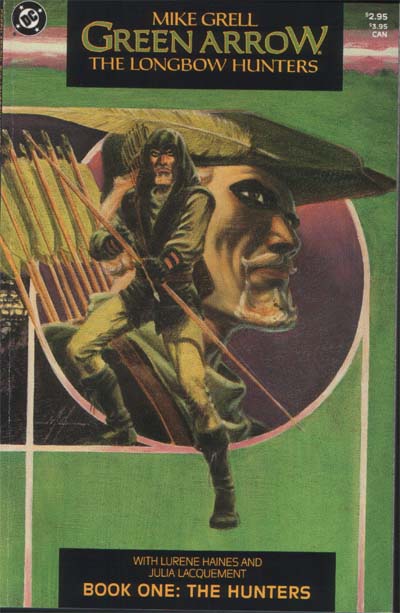 |
| Figure 908: Mike Grell’s Green Arrow: The Longbow Hunters was DC’s attempted follow-up to Batman: The Dark Knight Returns. |
So from DC’s perspective, the loss of Moore was largely not a big deal. He had played his role in the process, identifying both the serious-minded take on superheroes and a fresh style of horror comics that proved to sell well. These, combined with ideas like the prestige format used for The Dark Knight Returns and the permanently-in-print trade paperback collection used for Watchmen, were more than enough for them to do what they wanted without any need to deal with the eccentrically principled. And for the most part they did. Moore’s run on Swamp Thing was followed smoothly by Rich Veitch taking over the writing while continuing on art, creating an easy transition and remaining in the same basic style. Jamie Delano, a close friend of Moore’s who had previously followed him on both Captain Britain and D.R. & Quinch, started up Hellblazer, featuring John Constantine, giving DC a second book in the Swamp Thing mould. Plus there were plenty of writers who came up through the same publications that Moore had who could be hired to do similar work. And DC continued with the grim realism introduced by Moore and Miller, putting out Mike Grell’s enormously successful prestige format Green Arrow: The Longbow Hunters, which reworked the title character to no longer use silly trick arrows, and with a plot that included the brutal torture of Black Canary followed by Green Arrow killing her torturer. And all of this was on top of things like John Byrne’s massively successful take on Superman, Marv Wolfman’s perennially popular Teen Titans comics, Dennis O’Neil’s acclaimed run on The Question, and former Dick Tracy scribe Max Allan Collins’s doing a brief stint on Batman. It was, in other words, still an extraordinarily good period for DC.
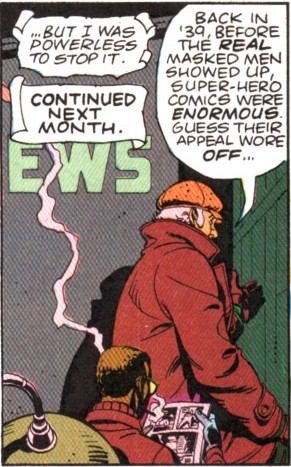 But there is a visible absence in all of this. The Veitch Swamp Thing and Delano Hellblazer runs were excellent books, and will come into focus within the War in good time, but their success in reprints has been a fraction of what Moore’s run has done. The Longbow Hunters sold well and remains in print, but is nothing compared to The Dark Knight Returns, and back issues go for roughly cover price, as opposed to the massive valuation of its predecessor. And as for Watchmen, well, there’s not even an obvious choice to compare it to. In the thirty years since its debut, DC has simply never come close to replicating its success. That they never matched the success of what is arguably the single most successful superhero graphic novel in the history of the genre is, of course, baked into the premise of Watchmen being the most successful, but to have the only other book to challenge it for the title, The Dark Knight Returns, be from the same year is, by any standard, a shocking failure at DC’s primary goal of replicating its own successful formula.…
But there is a visible absence in all of this. The Veitch Swamp Thing and Delano Hellblazer runs were excellent books, and will come into focus within the War in good time, but their success in reprints has been a fraction of what Moore’s run has done. The Longbow Hunters sold well and remains in print, but is nothing compared to The Dark Knight Returns, and back issues go for roughly cover price, as opposed to the massive valuation of its predecessor. And as for Watchmen, well, there’s not even an obvious choice to compare it to. In the thirty years since its debut, DC has simply never come close to replicating its success. That they never matched the success of what is arguably the single most successful superhero graphic novel in the history of the genre is, of course, baked into the premise of Watchmen being the most successful, but to have the only other book to challenge it for the title, The Dark Knight Returns, be from the same year is, by any standard, a shocking failure at DC’s primary goal of replicating its own successful formula.…
So I quite like “The Passenger”. It’s one of those sixth/first season episodes that tends to get criticized for “not being Deep Space Nine enough”, meaning its a tech mystery, doesn’t involve gratuitous action scenes and people are reasonably personable to each other. But to me, this is perfectly recognisable as Star Trek: Deep Space Nine and features much of what I love about this show in abundance.
One interesting thing to note about this episode, or at least where this episode falls in my coverage of the series, is that it’s a Morgan Grendel pitch with help from Michael Piller coming immediately after another episode with the exact same credit (though the teleplay for “The Passenger” also had help from Robert Hewitt Wolfe, who’s not on staff for Star Trek: The Next Generation). If Grendel is brought up in the discussion here though, it’s typically to compare “The Passenger” with his most famous work, “The Inner Light”. Both stories do, after all, deal with a person living on in some form after death within the mind of another person, and some people like to read “The Passenger” as a dark reflection of “The Inner Light”. Grendel didn’t mean for it to be though, and anyway the two episodes are only similar in a very superficial way: “The Inner Light” uses its premise to examine different kinds of utopianism and a life unexplored, while “The Passenger” uses its mainly as a plot device to set another mystery in motion.
Said mystery is a good fit for this story though, in a procedural sort of way: There’s a dangerous fugitive running amok on Deep Space 9, and the team have to work together using their various skillsets to find him. And in spite of any protestations that this setup is too “Next Generation-like”, this is a premise that actually works way better here: We’ve seen plenty of examples in the past where trying to do a story like this on Deep Space Nine‘s sister show requires a significant amount of hoop-jumping, often involving the Enterprise having to escort some shifty dudes for some strangled reason, typically interrupting the galactic exploration they really ought to be doing. But it makes far more narrative sense for your undesirables to crop up in the stationary setting of this show, especially given the fact said stationary setting is an interstellar port city.
So in “The Passenger” we get another good look at the Deep Space 9 team in the role of first responders, investigators, and local city officials. It’s a role we’ve not really seen them in since “Babel”, and not used quite to this extent since “A Man Alone” (though there’s a little bit of it in “Dax”, I suppose). I’ve said before I really like seeing this crew used this way (it’s probably my favourite alongside being intermediaries to Bajoran post-colonial politics) so no surprises I like it used here, but what I *really* like is how it develops the framework laid down earlier in the season and shows the main cast more comfortable in their roles and with each other.…
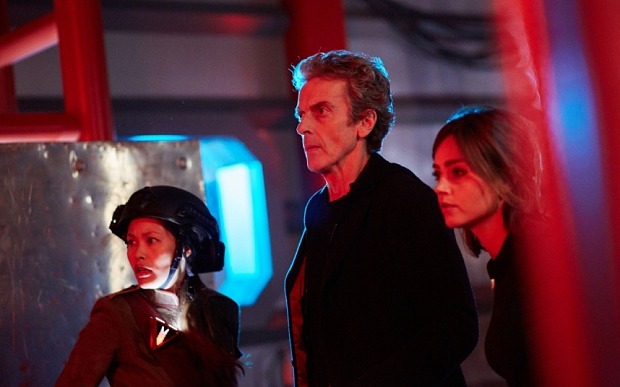 This week I’m joined by my former partner in crime over at Slate, playwright Mac Rogers, to talk about Sleep No More, Mark Gatiss, and whatever the fuck else we got off topic about. Which, being an Eruditorum Press podcast, was many, many things.
This week I’m joined by my former partner in crime over at Slate, playwright Mac Rogers, to talk about Sleep No More, Mark Gatiss, and whatever the fuck else we got off topic about. Which, being an Eruditorum Press podcast, was many, many things.
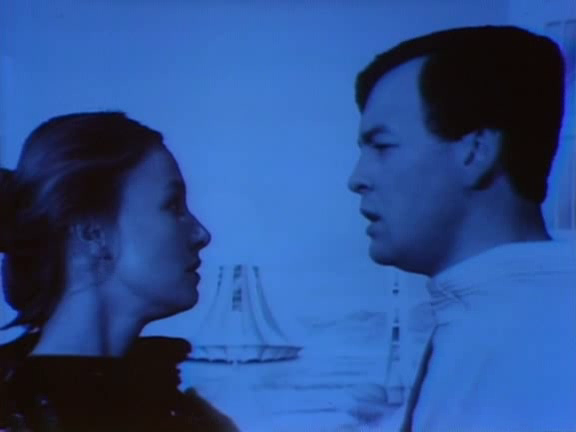 or ‘Young Men Are Dying For It’
or ‘Young Men Are Dying For It’
or ‘Don’t Mention the Chasms’
When I complain about the ideological message of this or that text, am I not tacitly admitting that Mary Whitehouse had a point? After all, isn’t the worry ultimately about the effect it will have?
We know that cultural artifacts influence people enormously. Moreover, most of us (and I definitely include myself in this) get most of our most deeply embedded ideas and assumptions about the world from fictional media rather than non-fiction. The News has a great influence on our ideas about the world… but, as Aristotle said, Tragedy is a great deal more philosophical than History because History treats of what happened whereas Tragedy treats of the kinds of things that happen, or that we think happen. Fiction is largely about representing our ideas about how people work and act in our society, about how they function in the world, and make the world, and interact with it. It is inherently social because to partake of fiction is to interact with all sorts of other people and social processes, and to take away from fiction an understanding of the world which then changes our interactions with it. This is one reason why unjust representations are such a big deal.
Fiction, I would argue, thus has a moral aspect baked into it. News, of course, partakes of all sorts of moral assumptions, and transmits all sorts of moral notions – often unconsciously to both journalist and consumer – but its essential claim is to represent fact, even if this is often spurious. Part of the appeal of fiction is that it bypasses fact and addresses itself to the socially ontological, to our notions of how the world is rather than the specific things which happen in it. Moreover, it directly addresses itself to morality, to our notions of justice and injustice. All fiction does this, whatever its content, because the act of reading or watching fiction is the act of imaginative empathy, of questioning oneself about how one would act if placed in the same position as the characters. (It’s important to note, in passing, that this is a great deal more complex than any platitude about ‘identification’.) This is partly why fiction is a great deal more popular than non-fiction.
Fiction is also crafted to appeal directly at a pre-rational, emotional level which by-passes intellectual judgements, at least as a first move (which is why you can be moved by utter trash). This is why its so immensely pleasurable, and also therefore so incredibly formative and influential. We’re also socialised to learn the art of reading (book or visual narrative) much earlier than we are taught to learn critical thinking or engagement with non-fiction. Stories are, after all, a form of play, and the role of play and games – experimentation ideally without fear of failure – in child socialisation is huge. So yeah, fiction has a terrific influence on how we think, how we view the world, society, other people, etc, on our normative assumptions about it, and on our moral judgements about it.…
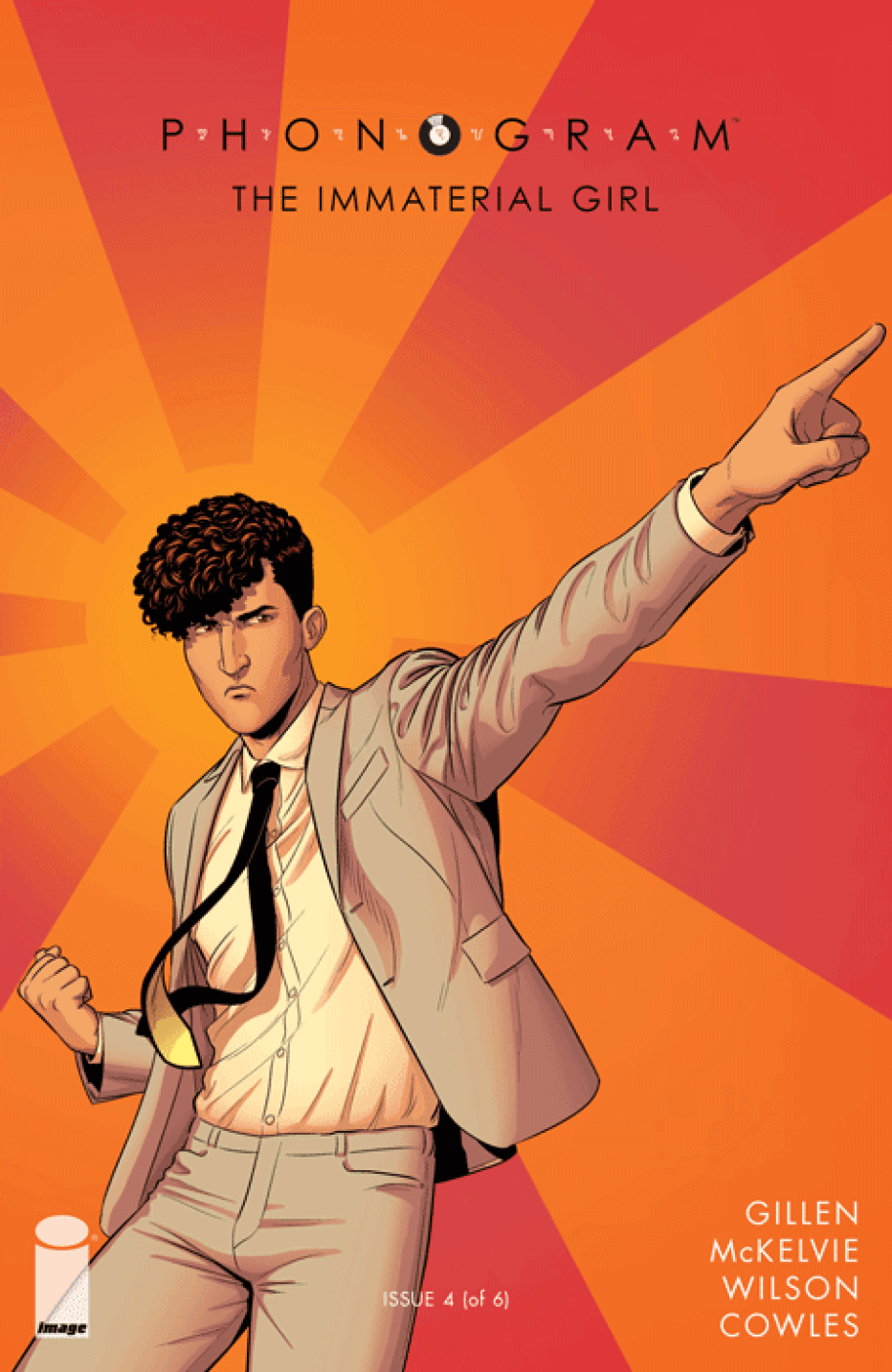 Vader Down #1
Vader Down #1
It’s a good week when this is the sort of thing occupying the bottom slot of my list, because there’s almost nothing wrong with it. You can, perhaps, tell that Aaron is better suited to his characters than Gillen’s – his dialogue for Aphra and company feels like a hollow imitation of the characters. But that’s a minor detail in a comic that giddily makes Vader seem tremendously powerful and tremendously fucked all at once. Good fun, and hard to imagine a Star Wars fan that isn’t going to be loving this.
The New Avengers #3
I love the pentacled Cthulhu villain that is Moridun. And the three-scenes-in-one banter at the start. And Power Man deciding to call out Wiccan on his name. And really most of this. And I’m fascinated by POD, a character I’m not actually sure I’ve registered as a thing before, but who is without a doubt the most interesting part of this issue. Good stuff; I think this is the current best of the Avengers books.
Ms. Marvel #1
Ms. Marvel punches gentrification. It’s as awesome as you’d hope from that description. The “artisinal sushi” line is probably my favorite of the week, and the backup story by Alphona is genuinely charming. Mike looks like a great character, and I can’t wait to see what Wilson ends up doing with her. While I definitely prefer Alphona’s art to Miyazawa’s, this series is clearly in wonderful hands as ever.
Phonogram: The Immaterial Girl #4
Gloriously out of left field, Phonogram swerves away from all of its apparent plots, connecting back to them only fleetingly and midway through, in an issue that’s mostly black and white for good measure. It’s the sort of thing that makes you genuinely surprised that we’re officially Done With Phonogram in two issues time, as it gestures to just how much there is to do with this world and these characters. How will this tie back in? Will it tie back in? What the fuck is Gillen doing? I have no idea, but I’m wholly confident it’s brilliant, so whatever. “I liked Claire Danes’s earlier, more difficult material” is definitely the second funniest line of the week though.…